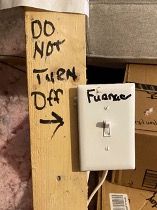Just this week, my daughter and her husband, who is dealing with the flu, woke up to a 58-degree house. They checked the vents and messed with the thermostat but couldn’t get the heat blowing. They called their landlord for a service call, but it was going to be a while before someone could come to check it out. Not wanting to wait half a day for heat, they decided they were going to get in the attic to see if the pilot light on the furnace was out. Before they went into the attic, I received a “what are we looking for?” call.
 I’m not an HVAC guy but I am a homeowner. I know some basic things to do, but I have never owned a gas furnace. I wasn’t too keen on them just lighting matches in the attic without really knowing what’s going on. Using the ole Questioning Attitude, I said to go look around and see if there is anything obvious and get the model number of the furnace. It might be a simple fix and we’ll look up that model to see if there are any procedures, troubleshooting guides, or videos explaining how to ignite the pilot light for that unit. When you get up there, I said, let’s FaceTime so I can give you a Peer Check.
I’m not an HVAC guy but I am a homeowner. I know some basic things to do, but I have never owned a gas furnace. I wasn’t too keen on them just lighting matches in the attic without really knowing what’s going on. Using the ole Questioning Attitude, I said to go look around and see if there is anything obvious and get the model number of the furnace. It might be a simple fix and we’ll look up that model to see if there are any procedures, troubleshooting guides, or videos explaining how to ignite the pilot light for that unit. When you get up there, I said, let’s FaceTime so I can give you a Peer Check.
Side note: When she was 16, my Human Performance efforts were met with an eye-roll the director of The Exorcist would be proud of. When she’s in a 58-degree house with a sick husband, she didn’t bat an eye.
 They found this exact switch (photo at right) in the off position.
They found this exact switch (photo at right) in the off position.
As it turns out, they had a roof leak the prior week. The roofers came out and repaired the leak, but the painters—who were there to fix the ceiling damage—went into the attic the day before the heat went out. One of two things likely happened. Either the painters, in a dark attic, tried this switch before they found the light switch (they were close together) or they accidentally bumped this switch off as they worked (it was in an area where this could easily happen).
We verified with the operating manual we found online that it was OK to just turn it back on and flipped this switch. Within a few minutes, warm air was blowing again and they canceled the maintenance call.
In Human Performance jargon, we would call this set-up an “error-likely situation” and it begs so many questions. Why was this switch even there? If you never turn it off, why is there a “turn it off” option? Why isn’t the furnace powered and controlled from the breaker box? Why was this switch located where it could be easily bumped or confused with a light switch? Why isn’t the switch covered or protected? Why is a handwritten sign (that only kind of reads “furnace”) our only guidance?
I turned to Google for some answers. The only thing I could find is that sometimes, during construction, the electricians will put this in the attic so the HVAC tech has an electrical disconnect within view. However, I also read posting after posting all saying some version of “I can’t tell you how many service-calls I go on and it’s just that the ‘furnace light switch’ was turned off.” Boxes bump the switch. Christmas lights are being pulled out of the attic and catch the switch. It was mistaken for a light switch. One particularly informative blog post even said, “This is an error-likely set-up (Yes!) so be sure not to make the mistake of turning it off (What!?).” If we need the switch (which we don’t from what I read), can we at least cover it and put it in a less conspicuous location? Switch covers would pay for themselves after you avoid just one unnecessary service call—not to mention the avoided inconvenience of a cold house.
Another Human Performance concept is the idea of “extent of condition.” In other words, if we find an issue or latent organizational weakness, we need to ask, “Where else could this be a problem?” So, let’s extend that Questioning Attitude to our workplace today.
Do you have informal signs and guidance around your facility? Are there handwritten labels in the plant? Are they accurate? Are there sticky notes on panels or control boards? Do they still apply, and do they make sense? Do your procedures have handwritten notes in the margins that have not been verified or gone through a procedure revision process? Are there cautions or warnings to avoid us taking an action when the solution should be to not make that action an option? If we aren’t turning it off, why is there an off switch?
Don’t mistake a sign, note, or label for a fix. Don’t assume Sharpie writing on the wall is correct. Don’t use sticky notes when you can revise the procedure. Most importantly, don’t roll your eyes when dad is trying to bring a little Human Performance home.
Toolbox Talks offers quick insights and thoughts to use for your toolbox (tailboard) talks. Dave Sowers is a founding member of Knowledge Vine, a veteran-owned human performance training and consulting organization that strives to reduce the frequency and severity of human errors in the workplace. He has almost 30 years of experience in power generation and the utility industry. He is a veteran of U.S. Navy Nuclear Power Program and holds a bachelor’s degree in resources management and a master’s degree in both management and emergency management and homeland security.



